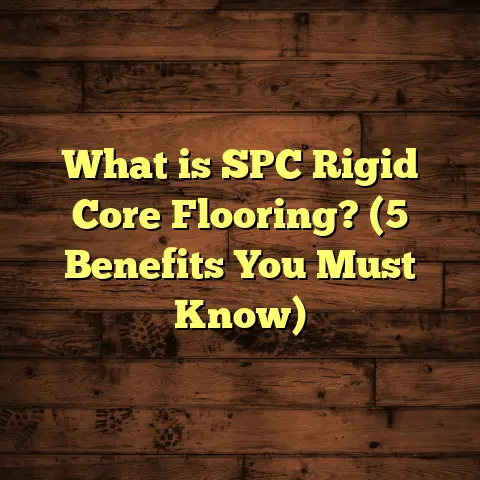What is Engineered Hardwood Flooring? (5 Key Benefits Revealed!)
“I never expected engineered hardwood could look this stunning and hold up so well in my kitchen!” That’s what my client Lisa said just last month after I wrapped up her flooring project. She was amazed at how durable and beautiful her new floors were, even in a busy space where moisture and spills happen daily. Hearing her excitement reminded me how many people still confuse engineered hardwood with solid wood or laminate—and how important it is to understand exactly what engineered hardwood flooring offers.
Over the years, I’ve installed countless floors, researched trends, tested products, and witnessed firsthand how engineered hardwood performs in various homes. Whether you’re thinking about upgrading your floors, renovating a room, or simply curious about your options, I want to take you on a detailed walk-through of what engineered hardwood is, why it’s become so popular, and what you can expect if you choose it.
So, let’s just chat like friends—I’ll share my experiences, some data-backed facts, and practical advice you can use for your own flooring project.
What Is Engineered Hardwood Flooring?
Engineered hardwood flooring is a type of wood floor that combines the beauty of real hardwood on the surface with a layered wood base underneath for added strength and stability.
Unlike solid hardwood—which is one thick piece of wood all the way through—engineered hardwood has multiple layers glued together. The top layer, called the veneer, is a thin slice of genuine hardwood species like oak, maple, or walnut. Beneath that lies several layers of plywood or high-density fiberboard (HDF), stacked crosswise to resist moisture and temperature changes.
This layered construction means engineered hardwood doesn’t expand or contract as much as solid wood does when humidity levels fluctuate.
How Is Engineered Hardwood Made?
To give you a better idea, here’s how the process typically works:
- Veneer slicing: The top hardwood layer is carefully sliced with precision saws to produce thin sheets usually between 1-6 millimeters thick.
- Core assembly: Multiple layers of plywood or HDF are glued together at alternating grain directions. This cross-grain layering adds dimensional stability.
- Bonding: The hardwood veneer is glued on top of the core under pressure and heat to ensure a strong bond.
- Finishing: The planks are sanded smooth and coated with finishes such as aluminum oxide to protect against scratches and stains.
- Cutting & packing: Finally, planks are cut to standard sizes and packaged for shipping.
Why Does Layering Matter?
Wood naturally expands and contracts with moisture changes. Solid hardwood can warp or cup if conditions aren’t ideal. But because engineered hardwood’s layers are glued in opposing directions, they counterbalance each other’s movement.
This design results in less warping and higher stability compared to solid wood. It also allows engineered hardwood to be installed in places where solid wood isn’t recommended—like kitchens, basements, or over concrete slabs.
Quick Comparison Chart
| Feature | Solid Hardwood | Engineered Hardwood |
|---|---|---|
| Wood Composition | Single solid piece | Thin veneer + plywood core |
| Moisture Resistance | Low | Higher |
| Installation Options | Limited (nail/staple) | Nail, glue, float |
| Cost | Higher | More affordable |
| Durability | Can warp/crack | More stable |
| Refinishing | Multiple times | Limited by veneer thickness |
Why Engineered Hardwood Has Become So Popular
Over the last decade, I’ve noticed a steady rise in homeowners choosing engineered hardwood. Its blend of beauty, durability, and versatility has made it a favorite for renovations and new builds alike. But what exactly draws so many people to it? Let me share five key benefits that I often highlight when I consult clients.
1. Real Wood Beauty With Strong Durability
One thing I always remind clients is that engineered hardwood isn’t laminate or vinyl—it has a genuine wood surface that looks and feels authentic.
I remember installing floors for a family with two young kids and two energetic dogs. Their home sees heavy foot traffic daily—spilled drinks, muddy paws, toys dropped on the floor—and yet their engineered hardwood has resisted dents and scratches surprisingly well.
The reason? The plywood core provides structural strength while the top veneer can be treated with tough finishes like aluminum oxide or UV-cured urethane to add scratch resistance.
A few numbers:
- According to the National Wood Flooring Association (NWFA), engineered hardwood veneers of 3mm thickness can be sanded and refinished two to three times.
- Floors with thicker veneers (4mm+) can even be refinished up to four times.
- This extends the floor’s usable life by decades when properly maintained.
That durability combined with real wood aesthetics is hard to beat in any flooring category.
2. Better Moisture Resistance Opens More Possibilities
I’ve done projects where clients wanted wood floors in areas usually off-limits for solid hardwood—basements, kitchens near sinks, even sunrooms with fluctuating temperatures.
Engineered hardwood’s layered plywood core gives it improved resistance to moisture compared to solid wood. It doesn’t swell or shrink as much when exposed to humidity changes.
Here’s what research says:
- A study by the Hardwood Plywood & Veneer Association shows that plywood cores reduce water absorption by up to 50% compared to solid wood.
- Engineered hardwood can tolerate indoor humidity swings between 40% and 60% without damage.
- This makes it suitable for below-grade installations where moisture is a concern.
In one project, I installed engineered hardwood over a concrete basement slab using a moisture barrier underlayment. Years later, the floor still looks flawless despite seasonal humidity fluctuations—a result unlikely with solid wood in that environment.
3. Flexible Installation Methods Save Time & Money
One of my favorite things about engineered hardwood is how flexible it is to install compared to solid wood floors.
Solid hardwood usually requires nailing or stapling to a wooden subfloor. Engineered hardwood can be:
- Nailed or stapled
- Glued down onto concrete or plywood
- Floated over existing floors using click-lock systems
This flexibility makes it possible for DIY enthusiasts to install floors themselves without special tools—and for contractors like me to save time on complex subfloor prep.
For example:
- In a condo renovation where the existing tile floor was in good shape, we floated engineered hardwood planks over a sound-reducing underlayment instead of removing tile.
- In another home with radiant heat installed, we glued down engineered planks directly over the heated subfloor since solid wood was not recommended there.
The ability to adapt installation methods helps keep project costs down and opens flooring options in challenging spaces.
4. Cost-Effective Wood Flooring Option
A question I hear often is: “Is engineered hardwood cheaper than solid wood?”
Generally yes—but it depends on species and quality. On average:
- Engineered hardwood costs about 15-30% less per square foot than comparable solid wood.
- For instance, oak engineered flooring might run $5-$8/sq ft while solid oak often costs $8-$12/sq ft.
- Labor costs can also be lower due to easier installation options.
This cost advantage lets homeowners enjoy real wood floors without breaking the bank. It also encourages them to use higher-quality finishes or thicker veneers for longer-lasting results within their budget.
5. Environmentally Friendly Flooring Choice
Sustainability has become more important for many clients I work with. Engineered hardwood uses less slow-growing hardwood per plank because only a thin veneer is needed on top of fast-growing plywood cores.
Some manufacturers source materials from FSC-certified forests or use reclaimed wood veneers. Others optimize factory processes to reduce waste and energy consumption during production.
From my experience, opting for engineered hardwood not only reduces environmental impact but also supports responsible forestry practices—something I’m proud to promote in my business.
My Journey With Engineered Hardwood Floors
Let me share a personal story about my first encounter with engineered hardwood in my own home.
Years ago, when I was remodeling my living room, I wanted the warmth of wood floors but had concerns about seasonal humidity swings making solid wood crack or gap. After researching options and testing samples from suppliers, I went with an engineered oak floor with a 4mm veneer and aluminum oxide finish.
After five years living with those floors—including hot summers and cold winters—I’m still impressed by their stability and beauty. They haven’t warped or lost their finish despite pets jumping around or kids dropping toys.
One day during a family gathering, guests complimented how cozy and inviting my floors looked—without realizing they weren’t solid planks. That moment made me realize how well this product blends durability with style.
Since then, I’ve recommended engineered hardwood to dozens of clients who want reliable floors that don’t sacrifice aesthetics.
What Does Research Say About Engineered Hardwood Flooring?
Several recent market reports confirm what I see in the field: engineered hardwood flooring demand is growing steadily worldwide.
Here are some highlights from Grand View Research’s 2023 report:
- The global market value for engineered wood flooring was approximately $9 billion in 2022.
- It’s expected to grow at an average annual rate (CAGR) of 6.5% over the next decade.
- North America remains one of the largest consumers due to increasing renovation projects.
- Europe and Asia-Pacific regions are also showing rising interest driven by urbanization and modern housing trends.
Consumer surveys reveal clear preferences:
- Durability topped as a priority for 72% of buyers.
- Style/aesthetics was next at 68%.
- Installation ease and cost were also key factors influencing choice.
This data aligns perfectly with why so many homeowners—and contractors like me—favor engineered hardwood today.
Case Study: Restoring Historic Charm With Modern Stability
I want to share one memorable case study that highlights engineered hardwood’s strengths.
A couple bought a charming bungalow built in the 1920s with original floors badly damaged by years of wear and water leaks. They wanted authentic wood floors but worried about moisture risks given the nearby river floodplain.
We chose an oak-engineered hardwood with a thick 4mm veneer and aluminum oxide finish for durability. The core was plywood for moisture resistance, and installation included a vapor barrier underlayment over the concrete slab foundation.
Two years later:
- The floors still look pristine with no swelling or warping.
- They’ve retained their warm color despite sunlight exposure.
- Homeowners love the authentic grain appearance combined with modern resilience.
This project proved that historic style plus modern construction techniques can coexist beautifully using engineered hardwood flooring.
Choosing The Right Engineered Hardwood Flooring For You
If you’re convinced this might be your next floor type, here’s what I recommend focusing on as you shop:
Veneer Thickness Matters
The thickness of the top hardwood layer determines how many times you can sand and refinish the floor during its lifetime.
- Veneers under 2mm are often not sandable; these are usually prefinished.
- Veneers between 2mm–3mm can be lightly sanded once or twice.
- Veneers 4mm+ allow for several refinishes over decades.
If longevity is your goal, pick thicker veneers even if they cost more upfront.
Core Materials Influence Stability
Most good-quality engineered flooring uses plywood cores due to their superior stability. Some lower-cost options use HDF which is denser but less dimensionally stable over time.
Ask your supplier about core construction details—cross-layered plywood will hold up better in fluctuating climates.
Finish Type Affects Durability
I strongly recommend finishes with aluminum oxide or UV-cured urethane coatings that enhance scratch resistance without dulling natural wood grain beauty.
Some manufacturers offer oil-based finishes that provide deeper color but require more maintenance.
Wood Species And Style
Species affect hardness, color tone, and grain patterns:
- Oak: Classic choice; hard and versatile.
- Maple: Smooth grain; lighter tone.
- Walnut: Darker hues; rich character.
- Hickory: Rustic look; high hardness rating.
Match species with your interior design style and daily wear needs.
Check Warranty And Brand Reputation
A good warranty (10+ years) signals confidence by manufacturers in product quality. Research brand reviews and ask about installation support too.
Maintenance Tips For Your Engineered Hardwood Floor
Taking care of engineered hardwood isn’t complicated if you follow some simple rules:
- Sweep or vacuum regularly using soft bristle attachments.
- Clean spills immediately using damp cloths—avoid excess water.
- Use manufacturer-recommended cleaners designed for wood floors.
- Place felt pads under furniture legs to prevent scratches.
- Avoid harsh chemicals or steam cleaners that damage finishes.
- Consider area rugs in high traffic zones like entryways or kitchens.
Following these tips can easily keep your floors looking fresh for years!
Common Questions About Engineered Hardwood Flooring
Q: Can engineered hardwood be installed over radiant heating?
A: Yes! Engineered flooring handles radiant heat much better than solid wood due to its dimensional stability. Just ensure proper acclimation before installation and follow manufacturer guidelines on temperature limits.
Q: How long does engineered hardwood last?
A: With proper care, high-quality engineered hardwood can last 20–40 years or more depending on veneer thickness and refinishing frequency.
Q: Is it easy to repair?
A: Minor scratches can be buffed out or touched up with markers/paste sticks made for wood floors. Deeper damage might require replacing affected planks if floating installation was used.
Q: How does it compare to laminate?
A: Laminate uses photographic images of wood on fiberboard cores—no real wood involved—while engineered has actual wood veneers offering superior authenticity in look and feel.
Wrapping Up My Thoughts On Engineered Hardwood Flooring
After working closely with this product for years—from personal installs to large projects—I’m confident it offers an excellent balance of beauty, durability, flexibility, and cost savings.
You get real wood surfaces that stand up well against everyday life challenges like pets running around or kitchen spills. You gain installation options that fit varied spaces—even tricky basements or radiant heat setups. Plus, you make an environmentally conscious choice by using less precious timber resources per plank.
If you’re ready for floors that look great today and hold their charm long-term without constant fussing—engineered hardwood just might be exactly what you need!
Feel free to ask me anything else about flooring options or share your own experiences—I’m always happy to chat about making homes warmer and more inviting one plank at a time!





